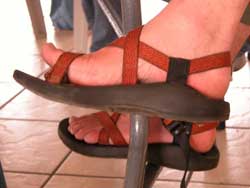 Diabetic foot ulcers are a leading cause for limb amputation among patients with diabetes. These ulcers can begin from a very small scratch, yet due to a lack of attention, the wound can become infected, leading to necrosis and the need for amputation.
Diabetic foot ulcers are a leading cause for limb amputation among patients with diabetes. These ulcers can begin from a very small scratch, yet due to a lack of attention, the wound can become infected, leading to necrosis and the need for amputation.
Currently, diabetes is one of the main health threats to the community. The disease causes various complications, among which lower limb complications, most prominently foot ulcers, greatly impact the mental and physical well-being of patients. These complications can be identified and monitored through visual observation, yet they often do not receive adequate attention from either doctors or patients.
Foot ulcers in diabetic patients can start from a tiny wound measuring just 3 mm—like a small scratch from an accidental bump. Patients with neuropathic complications may lose their ability to feel pain, making them more vulnerable to injuries without realizing it. If this small scratch is not treated promptly, it can become infected and lead to extensive ulceration and necrosis. The only way to prevent necrosis from spreading to other areas is to amputate the affected part.
Statistics show that nearly 60% of individuals undergoing lower limb amputation are diabetic patients, with 85% of these cases resulting from foot ulcers. For every five patients with foot ulcers, four have sustained injuries from external factors such as bumps or falls. The mortality rate following amputation is also very high and increases with the duration of the disease.
“The reason why diabetic patients experience such high rates of foot ulcers is that both doctors and patients do not prioritize daily foot care,” said Dr. Nguyen Thy Khue, an expert in diabetes at the University of Medicine and Pharmacy in Ho Chi Minh City. “In my research, I found that many patients have been visiting doctors for years without ever being asked about their feet. Doctors often conduct superficial examinations for diabetic patients, relying heavily on advanced techniques without paying attention to small details or the patient’s history. This lack of attention hampers timely detection of foot ulcer symptoms. Furthermore, patients often lack awareness and have not been sufficiently educated to recognize signs of foot ulcers themselves,” Dr. Khue added.
Timely detection of foot ulcer symptoms is crucial for maintaining health and preventing complications from worsening. It also helps mitigate negative thoughts and actions, as well as reduces the financial burden of treatment for patients. According to Dr. Khue, foot ulcers can not only lead to mental distress, decreased physical strength, and reduced work capacity but also significantly increase treatment costs.
Therefore, to minimize the consequences of foot ulcers, diabetic patients should prioritize daily foot care. It is essential to have a foot examination at least once a year. Regular checks should include skin condition, toenails, foot pulses, and pain sensation. Patients with neuropathic complications should have their feet examined at every medical visit.
Patients can perform self-examinations or have family members assist if they meet the following criteria: the patient needs to be able to bend their spine, flex and rotate their hip joints, and flex and rotate their knees; their eyes should be able to recognize a 3 mm wound on the sole of the foot.
Signs that indicate a patient may be at risk for foot ulcers include calluses, loss of sensation in the feet, small non-healing scratches, dry and cracked skin, and deformed toes. Upon noticing any unusual signs on the legs or feet, patients should seek medical advice immediately for timely preventive treatment.
Doctors also recommend that patients apply creams to prevent dry and cracked skin. Use a pumice stone on calluses and avoid letting calluses come into contact with scratches that could lead to infection. Toenails should be trimmed weekly. Always wear socks and shoes that fit well and are appropriate for the feet.
Currently, Vietnam lacks a specialized foot care department, making systematic and effective diagnosis and treatment of foot conditions challenging. Therefore, daily foot monitoring and care are crucial for diabetic patients.
Mỹ Lan




















































